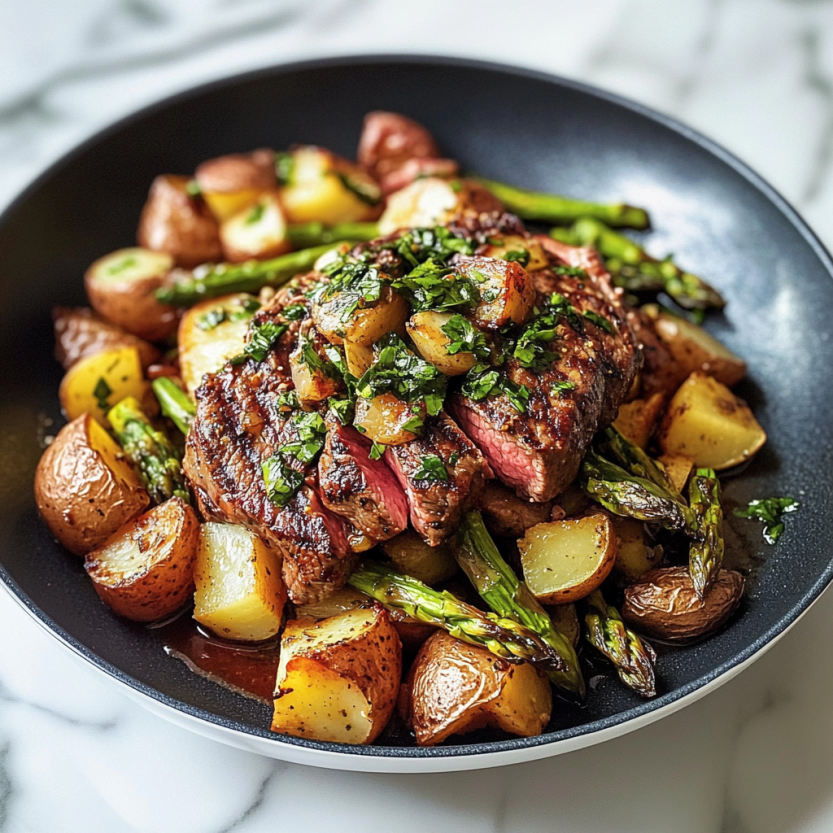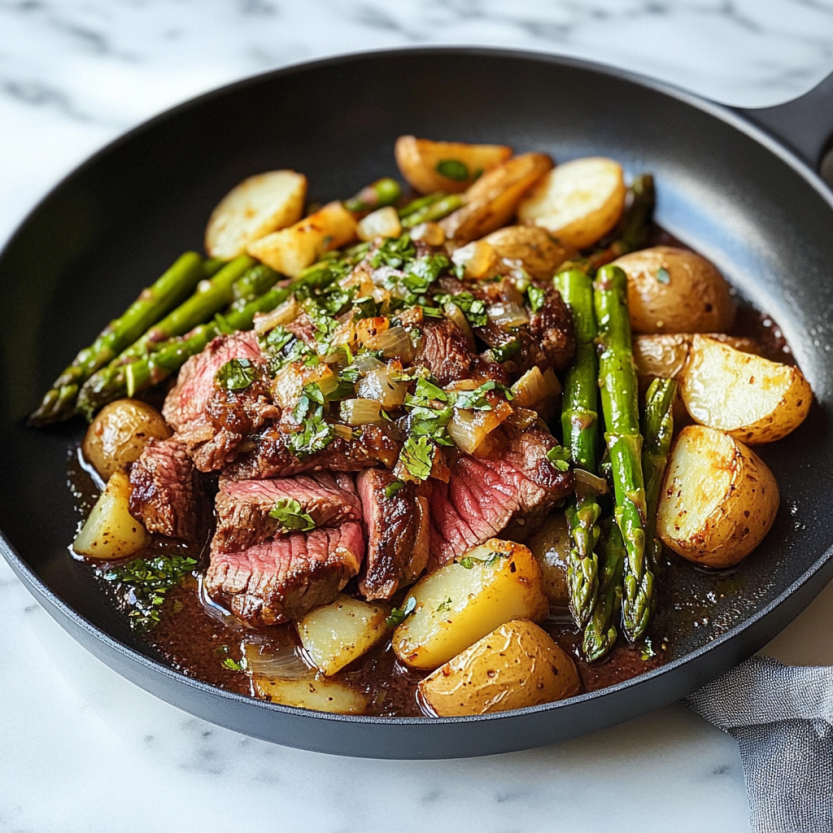 Bookmark
Bookmark
This one-pan skillet steak with asparagus and potatoes transforms your kitchen into a steakhouse without the intimidation factor. I've turned this recipe into my go-to impressive dinner when I want to impress guests without spending hours in the kitchen or creating a sink full of dishes.
I discovered this recipe when trying to recreate my favorite steakhouse meal at home during the pandemic. Now it's become my signature dish whenever I want to make something special without the stress of complicated techniques.
Ingredients
- Baby red potatoes these creamy potatoes roast to perfection and hold their shape while developing a beautiful golden crust
- Extra-virgin olive oil use a good quality oil since it flavors both the vegetables and the steak
- Asparagus choose bright green stalks with tight closed tips for the freshest flavor
- Smoked paprika adds a subtle smoky depth that complements the beef beautifully
- Garlic powder provides even flavor distribution throughout the crust of the steak
- Sirloin or strip steak look for well-marbled cuts about 1.5 inches thick for best results
- Fresh herbs parsley and mint create a bright, vibrant sauce that cuts through the richness of the steak
- Lemon both zest and juice bring acidity that balances the entire dish
- Red pepper flakes just a pinch adds subtle heat without overwhelming
Step-by-Step Instructions
- Prepare the potatoes
- Toss halved baby reds with olive oil and seasonings before roasting them first since they take the longest to cook. The cut side will develop a gorgeous golden crust against the hot skillet.
- Add the asparagus
- After the potatoes have started to tenderize, introduce the asparagus to the same pan. This timing ensures both vegetables finish cooking simultaneously without either becoming overdone.
- Prep and sear the steak
- Season generously with the spice mixture on both sides before adding to the hot skillet. A proper sear for 4-5 minutes per side creates that coveted crusty exterior that locks in juices.
- Finish in the oven
- Transfer the whole skillet to a moderate oven to bring the steak to your preferred doneness without burning the exterior. This gentle cooking method ensures even temperature throughout.
- Rest the meat
- The critical 15-minute rest period allows juices to redistribute throughout the steak, resulting in a moist, tender texture when sliced. Use this time to make your herb sauce.
- Create the herb sauce
- Whisk together fresh herbs, lemon, garlic, and olive oil to create a bright finishing touch that elevates the entire dish with minimal effort.
- Serve family style
- Arrange thinly sliced steak alongside the roasted vegetables and drizzle with herb sauce for a beautiful presentation straight from the skillet.
 Bookmark
Bookmark
The first time I made this recipe, I accidentally overcooked the asparagus while waiting for the potatoes to finish. Now I always start the potatoes first and add the asparagus later for perfectly cooked vegetables every time. My family considers this herb sauce so delicious they started requesting it on other dishes too.
Temperature Guide for Steak
The secret to restaurant-quality steak at home is monitoring internal temperature closely. For medium-rare, aim for 130-135°F before resting, as the temperature will continue rising about 5 degrees. Medium steaks should reach 140-145°F, while medium-well sits at 150-155°F. Always use an instant-read thermometer inserted into the thickest part for accuracy. Remember that carryover cooking during the resting period will continue raising the temperature slightly.
Seasonal Variations
This versatile recipe adapts beautifully throughout the year. In spring, substitute tender young green beans or snap peas for asparagus. Summer brings opportunities for garden-fresh cherry tomatoes added during the last few minutes of cooking. Fall calls for sweet potato substitutions with rosemary instead of mint in the herb sauce. Winter holidays feel festive with Brussels sprouts replacing asparagus and a spoonful of cranberry compote alongside. The cooking method remains identical regardless of your vegetable choices.
Wine Pairing Suggestions
This elegant yet straightforward meal deserves a properly paired wine. For red lovers, a medium-bodied Malbec or Zinfandel complements the smokiness from the paprika without overwhelming the herb sauce. If you prefer white wine, reach for an unoaked Chardonnay or Viognier that can stand up to the richness of the steak while highlighting the vegetable components. Rose enthusiasts will find a dry Provence-style rose works beautifully, especially during warmer months. Always serve red wines slightly cooler than room temperature for the best experience.
 Bookmark
Bookmark
Frequently Asked Questions About Recipes
- → How do I know when my steak is cooked to medium-rare?
For medium-rare steak, look for an internal temperature of 130-135°F when tested with a meat thermometer. The steak should feel slightly resistant when pressed with tongs but still have some give. The center will appear warm and pink when sliced. Remember that the steak will continue cooking slightly during the 15-minute rest period.
- → Can I substitute the herbs in the sauce?
Absolutely! While the parsley and mint combination creates a bright, fresh flavor profile, you can substitute with herbs like basil, cilantro, chives, or tarragon based on your preference. Just maintain the same total quantity to keep the sauce consistency correct. Rosemary and thyme would also work well but use them more sparingly as they have stronger flavors.
- → What's the best type of skillet to use for this dish?
A cast iron skillet is ideal for this dish because it can transition safely from stovetop to oven and maintains excellent heat retention for a perfect sear on the steak. If you don't have cast iron, any heavy-bottomed, oven-safe skillet will work. Just ensure it doesn't have plastic handles or components that could melt in the oven.
- → Can I prepare any elements of this dish ahead of time?
Yes! The herb sauce can be prepared up to 24 hours in advance and stored in an airtight container in the refrigerator. You can also pre-cut the vegetables and store them separately. For best results, however, the steak should be cooked just before serving to maintain its optimal temperature and texture.
- → What side dishes would complement this meal?
Since this is already a complete meal with protein and vegetables, you might just want to add a simple green salad dressed with olive oil and lemon juice. If you'd like additional sides, crusty bread would be perfect for soaking up the flavorful herb sauce, or a light soup as a starter would round out the meal nicely.
- → How do I ensure my asparagus doesn't overcook?
Asparagus cooks relatively quickly compared to potatoes. If your asparagus spears are particularly thin, you might want to add them a few minutes later than the recipe suggests. They should be bright green and tender-crisp when done. Test by piercing with a fork—there should be some resistance, but the fork should still slide through.
